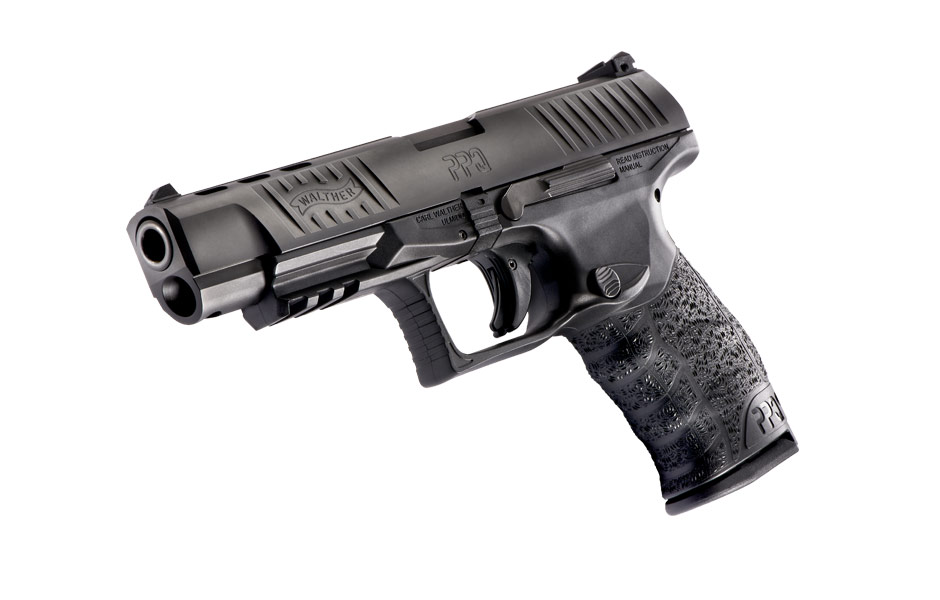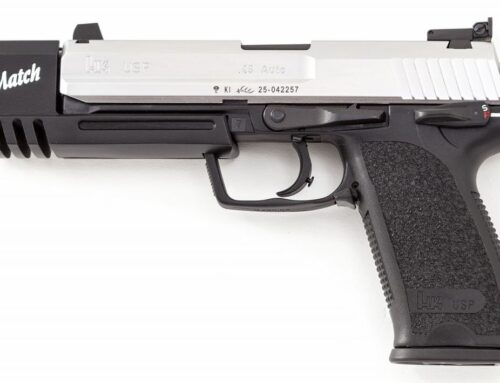This is one of those reviews which has managed to slip through the cracks and is long overdue, partly because of how impressive the Walther PPQ line of pistols is, and partly because I have something of an obsession with them as a result. For as many polymer framed and/or striker-fired pistols are currently on the market (and there are quite a few!) there is one model which I would give the crown to, hands down and no questions asked. I’ve never been a big fan of Walther before; they’ve had some hits and some misses. Then I had an opportunity to try out their PPQ M2.
The result was immediate and impressive, an eye-opening ‘oh my goodness’ revelation which left me feeling more excited and, dare I say giddy, than I have ever been over ‘yet another striker-fired polymer framed nine millimeter handgun.’ Having never fired one until this point, I put five rounds through my usual two handed stance then immediately went to five more just out of my dominant hand then finished out the last five with my non-dominant hand. After seeing the groupings I knew that I had to have one of these pistols.
To be perfectly honest, I bought two of them.
I had been searching the market for some time for a proper ambidextrous nine millimeter pistol. Something which was comfortable, easy to use, not too expensive, and (this is a big thing for me and my budding OCD-ness here) had symmetrical controls. Not all ambi pistols have full ambi controls, nor are they all built where the controls on the left side are the same as on the right. In some cases the left-handed controls are harder to operate as well. This was all really important to me, and the PPQ delivered. All I had to do with the M2 version was switch out one of the magazine releases and I had a mirrored pair of nine millimeters. There’s one year’s long quest which has come to an end! But there is so much more to this gun than looking incredible in a mirror.
The trigger. The trigger on this pistol is so fantastic that it’s the foundation for the very name of the series. ‘PPQ’ stands for ‘Police Pistol Quick Defense.’ Don’t ask me what happened to the D, I couldn’t tell you. Whatever engineering feat Walther undertook to create this trigger had been worth the trouble. It is what every striker-fired pistol strives to be. It’s not just a good trigger for a polymer striker-fired pistol, it’s just a really freaking good trigger. There’s some easy take-up before it reaches a notable stop then it’s just a little bit further to the break. The reset is so short that by the time you can think about it the darn thing’s already clicked back into place with a tactile and audible report. From there it’s right back to needing just that teeny bit of encouragement to fire again. This is the only stock trigger which has managed to catch me off guard once while firing off-hand. After putting hundreds of rounds through other guns I am still completely floored when I go back to shooting a PPQ. It never ceases to amaze me.
Ergonomics are another field which the PPQ scores top of its class. The only other pistol currently on the market which has come close to feeling so good in my hand is the HK VP9 series, yet where the HK has replaceable back panels and side panels, the Walther manages to get the job done with only three back panels. These grips feel so natural and fit my hands so exactly with the medium back panel that I can’t think of anything I would want changed. Whenever I get one into my palm the word that comes to mind is ‘bingo.’
Disassembly will be quite familiar to many shooters. Clear the pistol then drop the striker by pulling the trigger. Pull the slide back slightly then pull down on a tab just in front of the trigger. If you’ve ever field-stripped a Glock or Canik then you know exactly what to expect. Personally out of these three I find the Walther to be easiest to disassemble, the tabs are wider and seem to be much less resistant to work with.
The PPQ comes standard with two drop safeties and a firing pin block safety. The slides and barrels are given a Tenifer coating. The M2 can also be had with Flat Dark Earth, Olive Drab, or ‘Tungsten’ grey frames. Some models can be found in various Cerakote finishes too.
There are several different versions of this pistol currently available. There’s the PPQ M1, or what they now call the PPQ Classic, which uses a European style paddle magazine release that’s fully ambidextrous right out of the box. For those who prefer a thumb button style mag release there is the PPQ M2 model, which can easily be switched out for left or right handed use. There’s also the PPQ 22 and 45, which as the names suggest are chambered for .22 or .45. There’s the PPQ SC, their sub-compact model with a greatly reduced grip length and half an inch shaved off of the standard 4″ barrels. The Q4 Tac comes standard with a threaded barrel, an adjustable rear sight and fiber optic front sight and is complete with an optic mount. Last is the Q5 Match, a slightly tweaked 5″ barreled model which also has adjustable sights and is optic ready and features a distinct blue trigger and lightening cuts within the slide.
The PPQ M2 can be had in .40 S&W but the primary caliber for this series is 9mm. They can be had with 4″ or 5″ barrels (4.2″ for the .40 models and 4.25″ for the .45) or a 4.6″ threaded barrel. All of the newer pistols feature polygonal rifling, though I have seen an earlier M2 with more traditional land and groove rifling. Magazine capacity for the 9mm is 15 or 17 rounds. The PPQ 22 can be had with 10 or 12 round mags, both flush-fitting. The Sub-Compact holds 10 rounds in a flush fit mag but will accept any of the larger capacity mags. The .45 holds 12.
There’s also a pistol called the ‘Creed’ which has similar frame ergonomics to the PPQ, but it is a completely different breed.
So what’s the catch? Nothing is perfect and the PPQ does have its share of ‘ehs,’ but it’s not a big list and it’s mostly matters of personal preference. I’m not a big fan of the captive polymer recoil spring. While metal aftermarket guide rods are available from a few companies Walther has advised against it, though I’m not really sure why. To me the polymer ones feel flimsy and I do question their long term reliability.
Then there are the polymer sights which come standard on most of the models. The Q4 and Q5 models are spared from the ‘low-end’ windage adjustable only sights and Walther’s website has a version of the M2 listed with ‘W/XS F8 night sights’ which look to be a major improvement. Most of the PPQ’s come with some really flimsy sights which have three white dots painted right on the trailing edge. There’s no divot to protect the paint and I’ve personally had some of these sights get beat up in short order. On the upside sights for the Walther P99 will fit the PPQ’s and they are by far the easiest sights to replace on any handgun I have ever seen. Some sights have been reported to change the point of aim but I’ve outfitted both of mine with Trijicon three dot night sights originally made for the P99 and they’ve been dead-on. The front can be replaced with a Glock front sight hex driver while the back can be swapped out with a small screwdriver. There’s a spring-loaded plunger and a small click-adjustable screw for windage and the rear sight falls right out. It really is quite easy, even if you try to remove the sight from the wrong direction like I had. Read the directions first!
My final complaint comes from the PPQ 22, which I believe is made by Umarex and not Walther. I own one of these as well and to be honest it’s given me a lot of trouble. The point of impact is above the front sight on the .22 model, a matter which has thrown me for quite the loop for the first couple of range sessions. The ergonomics and controls are all the same, but the 22 model does not have a removable back panel. Accuracy has been mixed, the 12 round magazines can be less than reliable, and it seems to be very picky on what ammo it is fed. While a lot of fun to play with this model has also proven to be a source of frustration for me. I really wish that Walther would have made the PPQ 22 in house. The predecessor to the PPQ 22 is the P22, a pistol which seems to have a mixed history of its own.
One final point of consideration is how well these pistols will hold up with time, use, and exposure to the elements. From how great it is to shoot and how nice it feels in the hand I would easily rate this as the perfect polymer pistol, however it does not yet have the field time which some of its competitors have had the benefit of. While I feel this is the natural evolution of the striker-fired sidearms, I would love to see how well the PPQ’s hold up after another ten years of hard use. Regardless, I will never give up my M2’s. I sincerely hope that these guns see an increase in third party support as they absolutely deserve the recognition. (A pair of stand-off muzzle devices would not go amiss on my two!)
For all of my praise of the PPQ M2 it is capable of speaking for itself. I would encourage anyone from new shooters to experienced to give one a try here with us at the Range of Richfield. I’ve seen more PPQ’s showing up in holsters out here since I’ve started telling others about it so I know that I’m not alone in appreciating what Walther has created.








